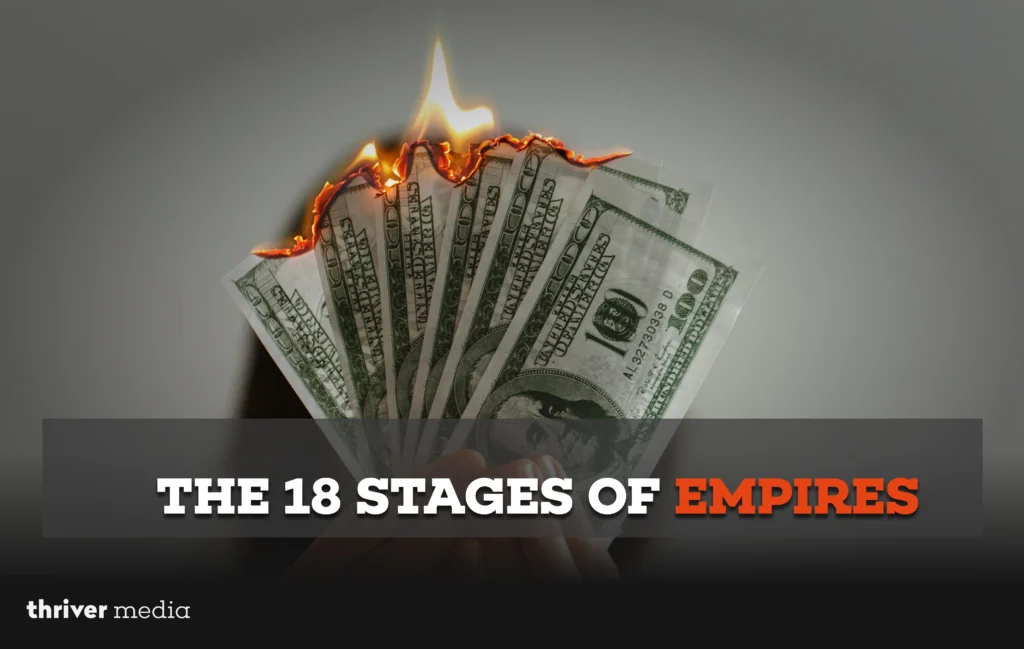The great geopolitical drama of our time is the shifting balance of power between the United States and China. We see it in trade wars, tech rivalry, and military posturing. But what if this isn’t just a temporary contest but part of an inevitable, historical cycle described in The 18 Stages of Empire?
A compelling model—gaining traction online—breaks the life of empires into 18 distinct stages. It doesn’t just describe history; it makes a bold, specific claim about the present: China is in its ascendant phase, while the United States is deep into decline, currently positioned at a critical Stage 17: Weak Leadership.
This isn’t just academic theory. It’s a framework that forces us to look past daily headlines and confront the powerful, cyclical forces that may be shaping our world. Let’s dive into this model and see if the shoe fits.

The Ascent of China’s Trajectory (Stages 1-8)
The first eight stages represent the hard work of building a superpower. This is the period of dynamism, unity, and explosive growth. According to the model, this is where China’s rise is currently demonstrated.
1. Strong Leadership: A central authority consolidates power and sets a clear national vision.
2. Inventiveness: A surge in innovation and problem-solving drives progress. (Think of China’s advancements in 5G, AI, and renewable energy).
3. Education: A focus on building a skilled, disciplined workforce to fuel the economic engine.
4. Culture: A strong, unifying national identity is promoted, fostering collective purpose.
5. Good Resource Allocation: The state effectively directs capital and resources toward strategic goals (e.g., the Belt and Road Initiative).
6. Good Competitiveness: The nation becomes a manufacturing and export powerhouse, undercutting global rivals.
7. Strong Income Growth: The economy booms, lifting millions out of poverty and creating new wealth.
8. Strong Markets & Financial Centers: The establishment of powerful domestic markets and global financial hubs (like Shanghai) solidifies economic influence.
This phase is characterized by a sense of momentum and a belief that the future is bright—a narrative that closely aligns with China’s story over the past 30 years.
The Peak: The Turning Point (Stages 9-12)
Reaching the zenith is deceptive. The very successes of the ascent plant the seeds of decay. This phase represents the plateau where a dominant power begins to show vulnerabilities.
9. Less Productive: Complacency sets in. The hunger to innovate wanes as the economy matures.
10. Overextended: The empire stretches its military, financial, and diplomatic resources too thin across the globe.
11. Losing Competitiveness: Newer, more agile rivals emerge, challenging the established order in key industries.
12. Wealth Gaps: The prosperity of the rise is not shared equally, leading to deep social and economic fractures.
This is the critical inflection point where an empire must reinvent itself or begin the downward slide.
The Descent of America’s Position at Stage 17 (Stages 13-18)
This is where the model becomes particularly provocative. It suggests the United States is navigating the later stages of decline, with the most critical danger being Stage 17: Weak Leadership.
13. Large Debts: The costs of overextension and social programs lead to unsustainable national debt.
14. Printing Money: To manage debt and stimulate the economy, central banks engage in quantitative easing, risking currency devaluation and inflation.
15. Internal Conflict: Deep political polarization, social unrest, and a loss of shared national identity become dominant features of public life.
16. Loss of Reserve Currency Status: Global confidence in the empire’s economy wanes, threatening the status of its currency as the world’s primary reserve asset (like the U.S. dollar).
17. Weak Leadership: (The stage identified for the USA). The political system struggles to produce leaders capable of addressing fundamental challenges. Governance is marked by gridlock, short-term thinking, and an inability to execute long-term strategy.
18. Civil War/Revolution: The final stage is a collapse of the old order, making way for a “New Order.”
The model’s placement of the U.S. at Stage 17 is a stark warning. It implies that the window for course correction is narrow and that the quality of leadership is the decisive factor between managed decline and catastrophic failure.
Conclusion: A Cycle, Not a Destiny
The “18 Stages of Empire” model is a powerful, if simplified, lens for understanding history and our present moment. Its direct application to the USA-China superpower dynamic makes it impossible to ignore.
However, it is a descriptive model, not a prophetic one. History suggests cycles are real, but human agency through visionary leadership, institutional reform, and technological breakthroughs can alter the trajectory.
The real value of this model is the conversation it starts. Are we witnessing an immutable cycle play out? Or can the U.S. address its internal divisions and reinvent itself while China navigates the immense challenges of its own rise?
What do you think? Does this model accurately reflect the current state of global power? Share your thoughts in the comments below















